Moderate overlap front: original test
Rating applies to 2002-07 models
Tested vehicle: 2001 Dodge Grand Caravan Sport
The Dodge Grand Caravan and Chrysler Town and Country were redesigned for the 2001 model year.
The Insurance Institute for Highway Safety has evaluated the crashworthiness of the Grand Caravan in three 40 mph moderate overlap frontal crash tests into deformable barriers. After the first test, Chrysler indicated the results were different from tests the company had conducted and requested a retest.
Results of the second test were more consistent with company test results for structural performance, but the amount and pattern of intrusion were similar. More significantly, a fuel leak occurred, revealing a weakness in the design of a circular fitting where the fuel lines exit the fuel tank. Further examination of the fitting in the van tested first showed stress fractures in the same area as the leak in the second van.
A third test was conducted after Chrysler made a design change to fix the fuel tank fitting and retrofitted a 2001 model with the redesign (all 2002 and later models include the modification). Examination of the redesigned fitting after the third test indicated no damage.
| Evaluation criteria | Rating |
|---|---|
| Overall evaluation | |
| Structure and safety cage | |
| Driver injury measures | |
| Head/neck | |
| Chest | |
| Leg/foot, left | |
| Leg/foot, right | |
| Driver restraints and dummy kinematics | |
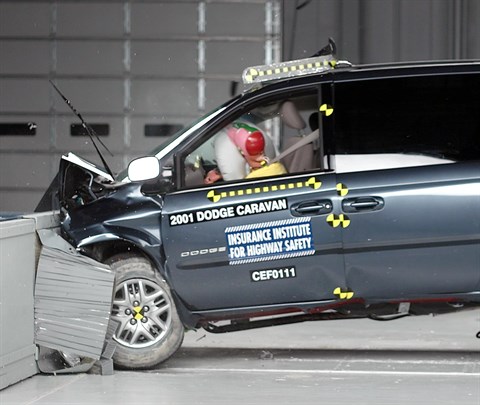
Action shot taken during the last of three frontal offset crash tests.

The driver's survival space was maintained reasonably well, as indicated by the dummy's position in relation to the steering wheel and instrument panel after the third crash test.
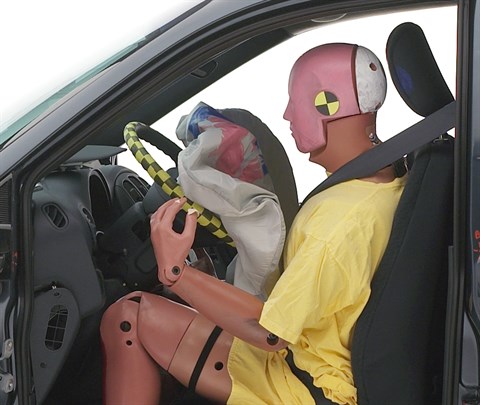
The dummy's head bottomed out the airbag and hit the steering wheel in the first two tests. In the second test (pictured), there also was too much upward movement of the steering wheel.
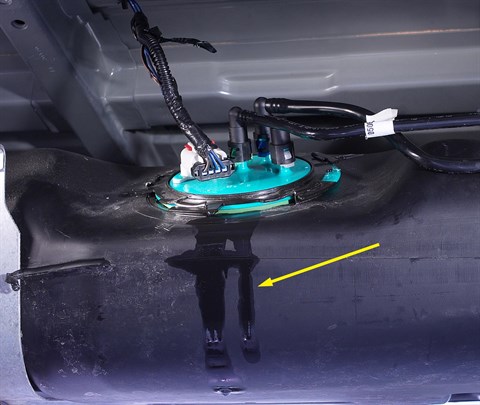
In the second test, a large amount of the fluid in the fuel system leaked from a circular fitting (green plastic) on top of the fuel tank. Leaking fluid is visible (arrow) running down the side of the black plastic fuel tank.
Measures of occupant compartment intrusion on driver side
| Evaluation criteria | Measurement | ||
|---|---|---|---|
| Test ID | CEF0102 | CEF0111 | CF00028 |
| Footwell intrusion | |||
| Footrest (cm) | 7 | 9 | 10 |
| Left (cm) | 14 | 19 | 24 |
| Center (cm) | 21 | 24 | 26 |
| Right (cm) | 20 | 22 | 26 |
| Brake pedal (cm) | 14 | 17 | 23 |
| Instrument panel rearward movement | |||
| Left (cm) | 0 | 1 | 4 |
| Right (cm) | 1 | 2 | 4 |
| Steering column movement | |||
| Upward (cm) | 11 | 9 | 8 |
| Rearward (cm) | -5 | -2 | 0 |
| A-pillar rearward movement (cm) | 1 | 2 | 2 |
Driver injury measures
| Evaluation criteria | Measurement | ||
|---|---|---|---|
| Test ID | CEF0102 | CEF0111 | CF00028 |
| Head | |||
| HIC-15 | 602 | 456 | 587 |
| Peak gs at hard contact | 81 | no contact | 71 |
| Neck | |||
| Tension (kN) | 2.0 | 1.9 | 1.8 |
| Extension bending moment (Nm) | 30 | 19 | 18 |
| Maximum Nij | 0.43 | 0.41 | 0.38 |
| Chest maximum compression (mm) | 34 | 41 | 51 |
| Legs | |||
| Femur force - left (kN) | 5.2 | 7.7 | 7.2 |
| Femur force - right (kN) | 1.9 | 1.6 | 2.1 |
| Knee displacement - left (mm) | 1 | 0 | 0 |
| Knee displacement - right (mm) | 3 | 2 | 2 |
| Maximum tibia index - left | 0.60 | 0.48 | 0.68 |
| Maximum tibia index - right | 1.70 | 1.27 | 1.06 |
| Tibia axial force - left (kN) | 1.8 | 1.2 | 0.9 |
| Tibia axial force - right (kN) | 9.3 | 6.6 | 7.1 |
| Foot acceleration (g) | |||
| Left | 63 | 59 | 71 |
| Right | 142 | 134 | 273 |
Side: original test
Rating applies to 2006-07 models built after December 2005
Tested vehicle: 2006 Dodge Grand Caravan SXT with head curtain airbags for all three rows of seats
The Dodge Grand Caravan and Chrysler Town and Country were redesigned for the 2001 model year. A modification was made beginning with 2002 models to fix a fuel tank fitting that contributed to a fuel leak in one of the Institute's frontal offset tests of a 2001 model.
Beginning with 2006 models manufactured after December 2005, further changes including additional B-pillar reinforcements, a modified roof structure, side curtain airbag updates, and modified door trim panels were made to improve occupant protection in side impact crashes (note: information about when a specific vehicle was manufactured is on the certification label typically affixed to the car on or near the driver door).
Two tests of the Grand Caravan were conducted, one with an optional side airbag for the driver and rear passenger, and one without. These vehicles are rated separately, except that the structural ratings for both vehicles are based on both tests. The tested vans were manufactured after all modifications had been made.
| Evaluation criteria | Rating |
|---|---|
| Overall evaluation | |
| Structure and safety cage | |
| Driver injury measures | |
| Head/neck | |
| Torso | |
| Pelvis/leg | |
| Driver head protection | |
| Rear passenger injury measures | |
| Head/neck | |
| Torso | |
| Pelvis/leg | |
| Rear passenger head protection | |

View of the vehicle and barrier just after the crash test.

View of the vehicle after the crash with doors removed, showing the side airbag and damage to the occupant compartment.

Action shot taken during the side impact crash test showing the driver dummy's head was protected from being hit by hard structures by the side curtain airbag.

Smeared greasepaint shows where the rear passenger dummy’s head was protected by the side airbag.
Measures of occupant compartment intrusion on driver side
| Test ID | CES0610 | CES0611 |
|---|---|---|
| B-pillar to longitudinal centerline of driver's seat (cm) | -9.5 | -12.0 |
| Negative numbers indicate the amount by which the crush stopped short of the seat centerline. | ||
Driver injury measures
| Evaluation criteria | Measurement |
|---|---|
| Test ID | CES0610 |
| Head HIC-15 | 273 |
| Neck | |
| Tension (kN) | 2.3 |
| Compression (kN) | 0.1 |
| Shoulder | |
| Lateral deflection (mm) | 33 |
| Lateral force (kN) | 2.0 |
| Torso | |
| Maximum deflection (mm) | 54 |
| Average deflection (mm) | 37 |
| Maximum deflection rate (m/s) | 4.12 |
| Maximum viscous criterion (m/s) | 1.17 |
| Pelvis | |
| Iliac force (kN) | 2.7 |
| Acetabulum force (kN) | 2.3 |
| Combined force (kN) | 4.9 |
| Left femur | |
| L-M force (kN) | 0.3 |
| L-M moment (Nm) | 51 |
| A-P moment (Nm) | -15 |
Passenger injury measures
| Evaluation criteria | Measurement |
|---|---|
| Test ID | CES0610 |
| Head HIC-15 | 100 |
| Neck | |
| Tension (kN) | 1.4 |
| Compression (kN) | 0.2 |
| Shoulder | |
| Lateral deflection (mm) | 29 |
| Lateral force (kN) | 0.0 |
| Torso | |
| Maximum deflection (mm) | 36 |
| Average deflection (mm) | 22 |
| Maximum deflection rate (m/s) | 5.23 |
| Maximum viscous criterion (m/s) | 0.89 |
| Pelvis | |
| Iliac force (kN) | 0.1 |
| Acetabulum force (kN) | 3.4 |
| Combined force (kN) | 3.5 |
| Left femur | |
| L-M force (kN) | 0.6 |
| L-M moment (Nm) | 97 |
| A-P moment (Nm) | 16 |
Rating applies to 2006-07 models built after December 2005
Tested vehicle: 2006 Dodge Grand Caravan SE without optional side airbags
The Dodge Grand Caravan and Chrysler Town and Country were redesigned for the 2001 model year. A modification was made beginning with 2002 models to fix a fuel tank fitting that contributed to a fuel leak in one of the Institute's frontal offset tests of a 2001 model.
Beginning with 2006 models manufactured after December 2005, further changes including additional B-pillar reinforcements, a modified roof structure, side curtain airbag updates, and modified door trim panels were made to improve occupant protection in side impact crashes (note: information about when a specific vehicle was manufactured is on the certification label typically affixed to the car on or near the driver door).
Two tests of the Grand Caravan were conducted, one with an optional side airbag for the driver and rear passenger, and one without. These vehicles are rated separately, except that the structural ratings for both vehicles are based on both tests. The tested vans were manufactured after all modifications had been made.
| Evaluation criteria | Rating |
|---|---|
| Overall evaluation | |
| Structure and safety cage | |
| Driver injury measures | |
| Head/neck | |
| Torso | |
| Pelvis/leg | |
| Driver head protection The dummy's head was hit by the intruding barrier. This hit did not produce high head injury measures, but head impacts with intruding objects such as other vehicles, trees, and poles should be prevented. The high neck injury measures were recorded before the head was hit. |
|
| Rear passenger injury measures | |
| Head/neck | |
| Torso | |
| Pelvis/leg | |
| Rear passenger head protection The dummy's head was hit by the window frame of the rear passenger door. This impact did not produce high head injury measures, but the head protection is inadequate. |
|
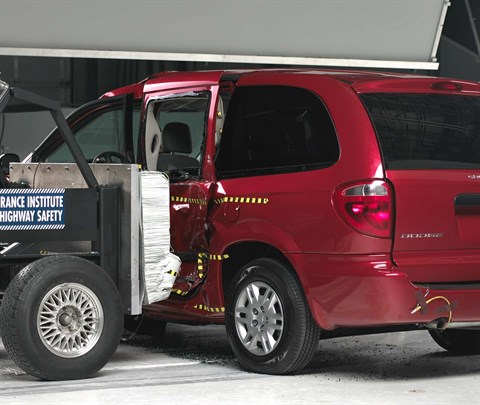
View of the vehicle and barrier just after the crash test.
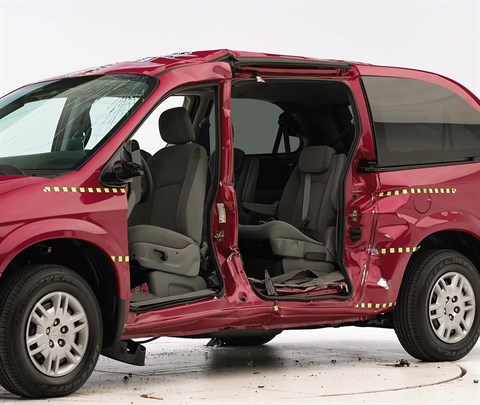
View of the vehicle after the crash with doors removed, showing the damage to the occupant compartment.
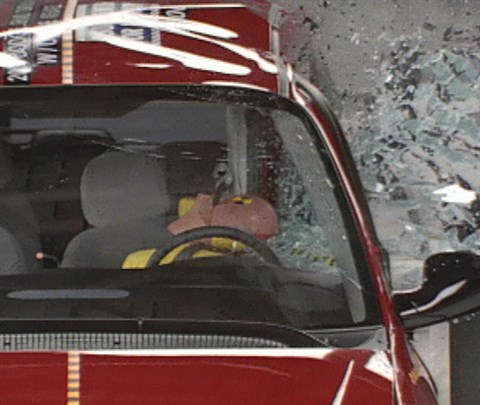
Action shot taken during the side impact crash test showing the driver dummy's head leaning well outward and hitting the crash test barrier.
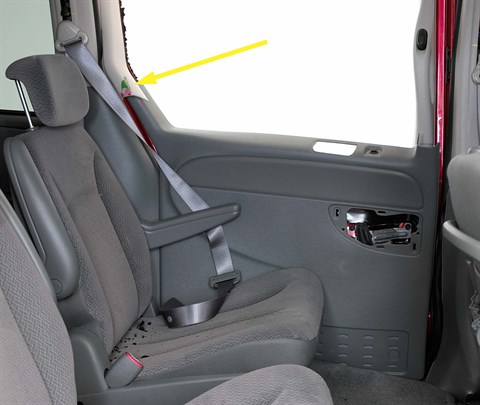
Smeared greasepaint shows where the rear passenger dummy’s head was hit by the window frame trim (dummy removed from van to show the impact point).
Measures of occupant compartment intrusion on driver side
| Test ID | CES0610 | CES0611 |
|---|---|---|
| B-pillar to longitudinal centerline of driver's seat (cm) | -9.5 | -12.0 |
| Negative numbers indicate the amount by which the crush stopped short of the seat centerline. | ||
Driver injury measures
| Evaluation criteria | Measurement |
|---|---|
| Test ID | CES0611 |
| Head HIC-15 | 383 |
| Neck | |
| Tension (kN) | 2.5 |
| Compression (kN) | 0.1 |
| Shoulder | |
| Lateral deflection (mm) | 34 |
| Lateral force (kN) | 2.1 |
| Torso | |
| Maximum deflection (mm) | 57 |
| Average deflection (mm) | 43 |
| Maximum deflection rate (m/s) | 5.58 |
| Maximum viscous criterion (m/s) | 1.30 |
| Pelvis | |
| Iliac force (kN) | 1.2 |
| Acetabulum force (kN) | 1.8 |
| Combined force (kN) | 3.1 |
| Left femur | |
| L-M force (kN) | 0.4 |
| L-M moment (Nm) | 48 |
| A-P moment (Nm) | 14 |
Passenger injury measures
| Evaluation criteria | Measurement |
|---|---|
| Test ID | CES0611 |
| Head HIC-15 | 102 |
| Neck | |
| Tension (kN) | 1.4 |
| Compression (kN) | 0.2 |
| Shoulder | |
| Lateral deflection (mm) | 28 |
| Lateral force (kN) | 1.2 |
| Torso | |
| Maximum deflection (mm) | 35 |
| Average deflection (mm) | 24 |
| Maximum deflection rate (m/s) | 6.15 |
| Maximum viscous criterion (m/s) | 0.87 |
| Pelvis | |
| Iliac force (kN) | 0.2 |
| Acetabulum force (kN) | 0.0 |
| Combined force (kN) | 0.2 |
| Left femur | |
| L-M force (kN) | 0.3 |
| L-M moment (Nm) | 70 |
| A-P moment (Nm) | 18 |
Head restraints & seats
Seat type: Seats with adjustable lumbar
| Overall evaluation | |
|---|---|
| Dynamic rating | |
| Seat/head restraint geometry |
| Seat type | Seats with adjustable lumbar |
|---|---|
| Geometry | |
| Backset (mm) | 72 |
| Distance below top of head (mm) | 78 |
| Seat design parameters | |
| Pass/fail | Fail |
| Max T1 acceleration (g) | 9.6 |
| Head contact time (ms) | 117 |
| Force rating | 1 |
| Neck forces | |
| Max neck shear force (N) | 87 |
| Max neck tension (N) | 635 |
Seat type: Seats without adjustable lumbar
| Overall evaluation | |
|---|---|
| Dynamic rating | |
| Seat/head restraint geometry |
| Seat type | Seats without adjustable lumbar |
|---|---|
| Geometry | |
| Backset (mm) | 82 |
| Distance below top of head (mm) | 75 |
| Seat design parameters | |
| Pass/fail | Fail |
| Max T1 acceleration (g) | 12.2 |
| Head contact time (ms) | 101 |
| Force rating | 3 |
| Neck forces | |
| Max neck shear force (N) | 231 |
| Max neck tension (N) | 900 |
About the head restraint & seat test
Currently, IIHS tests apply only to front seats.
